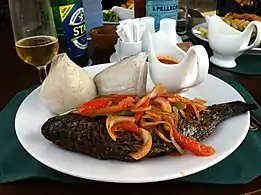Banku
Banku is a Ghanaian dish which is cooked by a mixture of fermented corn and cassava dough in hot water into a smooth, whitish paste,[1][2] served with soup, okra stew or a pepper sauce with fish.[3][4] It is mostly preferred by the people of the Southern Regions of Ghana; the Ewe people, the Fante people and the Ga-Adangbe people but also eaten across the other regions in Ghana. Banku is found throughout Ghana, and is one of the staple foods enjoyed by all tribes in the country although it is mostly associated with the Ewe people of Ghana. The Akan people have a softer variation of the food which they call Banku, while the Fante people have a little drier variant of the dish they call ɛtsew. [1][2][5]
 Balls of Banku | |
| Course | Pepper, Stew, Soup |
|---|---|
| Place of origin | Ghana |
| Serving temperature | Hot |
| Main ingredients | Corn dough, cassava dough, salt and water |
Gallery

Preparation


Preparation of the dough takes time. Cassava is peeled and chopped and mixed with corn grains and soaked for a day. The water is poured off and the cassava and maize is milled into dough which is smooth, fine and wet. The next stage in the preparation process is the fermentation of the dough. This takes between two to five days depending on climatic temperatures.[6]
Mix the corn dough and cassava dough in the deep stainless steel saucepan. Put over a medium flame and stir till the slurry begins to boil. Continue to stir gradually till the slurry becomes dough-like. Now, use your wooden spatula to knead the dough until it is smooth. When smooth, remove any dough stuck to the sides of your pan and center your dough. Add water around your "dough-in-pan-island", enough to almost cover the surface. Cover very well and allow to boil, ensuring even cooking and steaming of the dough in the covered pan. Knead with a spatula to incorporate the water into the dough until it is smooth. Repeat centering, watering, and kneading till your dough is soft and evenly cooked. Use a small bowl to dish a small portion of the banku into a bowl. Continue this process until the banku is finished from the deep stainless steel saucepan. It can be served with soup, stew or pepper with any meat or fish of your choice. Studies show that dishing banku into a rubber bag is unhealthy and quite poisonous.[7] The rubber bag can only be used when one waits for the banku to cool. The banku can be dished into a bowl right after preparation to avoid the stress of waiting for it to cool.[8]
See also
References
- Haard, N.F. (1999). Fermented Cereals: A Global Perspective. FAO agricultural services bulletin. Food and Agriculture Organization of the United Nations. p. 37. ISBN 978-92-5-104296-0.
- Briggs, P.; Rushton, K. (2007). Ghana: The Bradt Travel Guide. Bradt Guides. Bradt Travel Guides. p. 73. ISBN 978-1-84162-205-7.
- online reference, by J Dzeagu-Kudjodji and others ;"Banku". Retrieved 14 February 2015.
- "How to prepare Banku". Ghana Web. 13 December 2017.
- "Banku". ifood.tv/. Future Today Inc. Retrieved 14 February 2015.
- "Ghana: Banku". 196 flavors. 2019-06-25. Retrieved 2020-06-01.
- https://www.peacefmonline.com/pages/local/social/201512/265241.php
- Online, Peace FM. "Wrapping Banku In Polythene Equal To Smoking 136 Sticks Of Cigarette". www.peacefmonline.com. Retrieved 2020-06-14.




